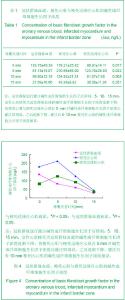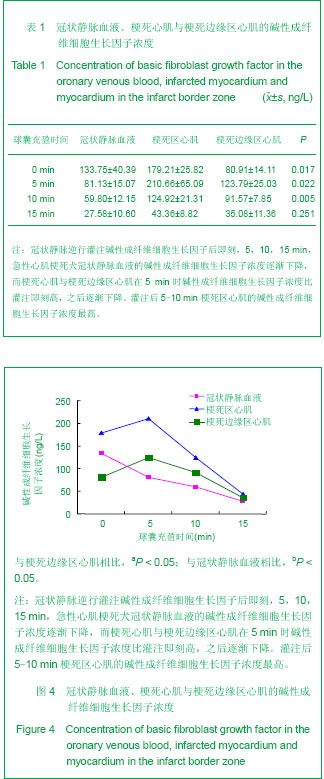Chinese Journal of Tissue Engineering Research ›› 2013, Vol. 17 ›› Issue (24): 4473-4480.doi: 10.3969/j.issn.2095-4344.2013.24.015
Previous Articles Next Articles
In vivo concentration gradient of basic fibroblast growth factor after coronary venous retrograde perfusion
Zhen Lei1, Wang Xiao1, Miu Huang-tai1, Qiao Shi-bin1, 2, Wu Xing-xin1, Qiao Yan3, Liu Bai-qiu3, Liu Xin-min3, Que Bin1, Nie Shao-ping1
- 1 Emergency and Critical Care Center, Beijing Anzhen Hospital, Capital Medical University, Beijing Institute of Heat, Lung and Blood Vessel Diseases, Beijing 100029, China
2 Department of Cardiology, People’s Hospital of Rizhao, Rizhao 276826, Shandong Province, China
3 Department of Cardiology, Beijing Anzhen Hospital, Capital Medical University, Beijing 100029, China
-
Received:2013-02-16Revised:2013-04-21Online:2013-06-11Published:2013-06-11 -
Contact:Nie Shao-ping, M.D., Chief physician, Doctoral supervisor, Emergency and Critical Care Center, Beijing Anzhen Hospital, Capital Medical University, Beijing Institute of Heat, Lung and Blood Vessel Diseases, Beijing 100029, China spnie@126.com -
About author:Zhen Lei★, Master, Emergency and Critical Care Center, Beijing Anzhen Hospital, Capital Medical University, Beijing Institute of Heat, Lung and Blood Vessel Diseases, Beijing 100029, China -
Supported by:General Program of National Natural Science Foundation of China, No. 81070166*, 81270284*; General Program of Science and Technology Planning of Beijing Municipal Education Commission, No. KM201010025020*
CLC Number:
Cite this article
Zhen Lei, Wang Xiao, Miu Huang-tai, Qiao Shi-bin, Wu Xing-xin, Qiao Yan, Liu Bai-qiu, Liu Xin-min, Que Bin, Nie Shao-ping. In vivo concentration gradient of basic fibroblast growth factor after coronary venous retrograde perfusion[J]. Chinese Journal of Tissue Engineering Research, 2013, 17(24): 4473-4480.
share this article

冠状静脉逆行灌注碱性成纤维细胞生长因子后即刻,5,10,15 min,急性心肌梗死犬冠状静脉血液的碱性成纤维细胞生长因子浓度逐渐下降,而梗死心肌与梗死边缘区心肌在5 min时碱性成纤维细胞生长因子浓度比灌注即刻高,之后逐渐下降。 灌注即刻,3组之间碱性成纤维细胞生长因子浓度的差异有显著性意义(P < 0.05);两两比较,梗死边缘区心肌的碱性成纤维细胞生长因子浓度低于冠状静脉血液和梗死心肌(P < 0.05);冠状静脉血液与梗死区心肌之间存在浓度梯度,但差异无显著性意义(P > 0.05)。灌注后 5 min和10 min两个时间点,3种组织之间碱性成纤维细胞生长因子浓度差异有显著性意义(P < 0.05);梗死区心肌浓度最高,且明显高于其他2种组织(P < 0.05)。灌注后15 min后3种组织之间碱性成纤维细胞生长因子浓度的差异无显著性意义(P > 0.05)。可以看出,灌注后(球囊充盈)5-10 min梗死区心肌的碱性成纤维细胞生长因子浓度与冠状静脉血液、梗死边缘区心肌之间存在显著梯度。 2.3 不良反应 冠状静脉逆行灌注成功率为100%。灌注前后心电图、心率和动脉压无明显变化。灌注过程中无心脏压塞和恶性心律失常等并发症发生。术中及术后无死亡。"

| 1. Wang Y, Liu XC, Zhang GW, et al. A new transmyocardial degradable stent combined with growth factor, heparin, and stem cells in acute myocardial infarction. Cardiovasc Res. 2009;84(3):461-469.http://www.ncbi.nlm.nih.gov/pubmed/195780692. Wang Y, Liu XC, Zhao J, et al. Degradable PLGA scaffolds with basic fibroblast growth factor: experimental studies in myocardial revascularization. Tex Heart Inst J. 2009;36(2):89-97.http://www.ncbi.nlm.nih.gov/pubmed/194368003. Zen K, Okigaki M, Hosokawa Y, et al. Myocardium-targeted delivery of endothelial progenitor cells by ultrasound-mediated microbubble destruction improves cardiac function via an angiogenic response. J Mol Cell Cardiol. 2006;40(6):799-809.http://www.ncbi.nlm.nih.gov/pubmed/166782004. Peng X, Wang B, Wang T, et al. Expression of basic fibroblast growth factor in rat liver fibrosis and hepatic stellate cells. J Huazhong Univ Sci Technolog Med Sci. 2005;25(2):166-9, 222.http://www.ncbi.nlm.nih.gov/pubmed/161169635. Kuhlmann CR, Scharbrodt W, Schaefer CA, et al. Discordant effects of nicotine on endothelial cell proliferation, migration, and the inward rectifier potassium current. J Mol Cell Cardiol. 2005;38(2):315-322.http://www.ncbi.nlm.nih.gov/pubmed/156988386. Scharbrodt W, Kuhlmann CR, Wu Y, et al. Basic fibroblast growth factor-induced endothelial proliferation and NO synthesis involves inward rectifier K+ current. Arterioscler Thromb Vasc Biol. 2004;24(7):1229-1233.http://www.ncbi.nlm.nih.gov/pubmed/151309127. Stamm C, Nasseri B, Choi YH, et al. Cell therapy for heart disease: Great expectations, as yet unmet. Heart Lung Circ. 2009;18(4):245-256.http://www.ncbi.nlm.nih.gov/pubmed/191190768. Ptaszek LM, Mansour M, Ruskin JN, et al. Towards regenerative therapy for cardiac disease. Lancet. 2012;379(9819):933-942.http://www.ncbi.nlm.nih.gov/pubmed/224057969. Lebherz C, von Degenfeld G, Karl A, et al. Therapeutic angiogenesis/arteriogenesis in the chronic ischemic rabbit hindlimb: effect of venous basic fibroblast growth factor retroinfusion. Endothelium. 2003;10(4-5):257-265.http://www.ncbi.nlm.nih.gov/pubmed/1466008610. Tomanek RJ, Sandra A, Zheng W, et al. Vascular endothelial growth factor and basic fibroblast growth factor differentially modulate early postnatal coronary angiogenesis. Circ Res. 2001;88(11):1135-1141.http://www.ncbi.nlm.nih.gov/pubmed/1139777911. Isern J, Mendez-Ferrer S. Stem cell interactions in a bone marrow niche. Curr Osteoporos Rep. 2011;9(4):210-218.http://www.ncbi.nlm.nih.gov/pubmed/2193202012. Schmidt A, Ladage D, Schinkothe T, et al. Basic fibroblast growth factor controls migration in human mesenchymal stem cells. Stem Cells. 2006;24(7):1750-1758.http://www.ncbi.nlm.nih.gov/pubmed/1682288313. Jiang CG. Beijiing: Renmin Junyi Chubanshe. 2006.江朝光.实用实验动物外科技术[M]. 北京:人民军医出版社,2006.http://book.knowsky.com/book_943956.htm14. Hanna AK, Durán WN, Leconte I, et al. Adenoviral-mediated expression of antisense RNA to basic fibroblast growth factor reduces tangential stress in arterialized vein grafts. J Vasc Surg. 2000;31(4):770-780.http://www.ncbi.nlm.nih.gov/pubmed/1075328515. Pelz J, Mollwitz M, Stremmel C, et al. The impact of surgery and mild hyperthermia on tumor response and angioneogenesis of malignant melanoma in a rat perfusion model. BMC Cancer. 2004;4:53.http://www.ncbi.nlm.nih.gov/pubmed/1532445716. Muramatsu M, Yamada M, Takai S, et al. Suppression of basic fibroblast growth factor-induced angiogenesis by a specific chymase inhibitor, BCEAB, through the chymase-angiotensin-dependent pathway in hamster sponge granulomas. Br J Pharmacol. 2002;137(4):554-560.http://www.ncbi.nlm.nih.gov/pubmed/1235963817. Haider H, Akbar SA, Ashraf M. Angiomyogenesis for myocardial repair. Antioxid Redox Signal. 2009;11(8):1929-1944.http://www.ncbi.nlm.nih.gov/pubmed/1936125418. Qin X, Wu F, Wang C, et al. Xinzhang Zazhi. 2012;24(3):4.秦星,武峰,王晨,等.经心内膜心肌内移植猪自体骨髓间充质干细胞治疗心肌梗死的实验方法[J].心脏杂志,2012,24(3):4.http://www.cnki.com.cn/Article/CJFDTotal-XGNZ201203011.htm19. Kaga T, Kawano H, Sakaguchi M, et al. Hepatocyte growth factor stimulated angiogenesis without inflammation: differential actions between hepatocyte growth factor, vascular endothelial growth factor and basic fibroblast growth factor. Vascul Pharmacol. 2012;57(1):3-9.http://www.ncbi.nlm.nih.gov/pubmed/2236133420. Lee YS, Jang HS, Kim JM, et al. Adenoviral-mediated delivery of early growth response factor-1 gene increases tissue perfusion in a murine model of hindlimb ischemia. Mol Ther. 2005;12(2):328-336.http://www.ncbi.nlm.nih.gov/pubmed/1604310121. Herity NA, Lo ST, Oei F, et al. Selective regional myocardial infiltration by the percutaneous coronary venous route: A novel technique for local drug delivery. Catheter Cardiovasc Interv. 2000;51(3):358-363.http://www.ncbi.nlm.nih.gov/pubmed/1106612622. Yokoyama S, Fukuda N, Li Y, et al. A strategy of retrograde injection of bone marrow mononuclear cells into the myocardium for the treatment of ischemic heart disease. J Mol Cell Cardiol. 2006;40(1):24-34.http://www.ncbi.nlm.nih.gov/pubmed/1627172323. Jain AK, Smith EJ, Rothman MT. The coronary venous system: An alternative route of access to the myocardium. J Invasive Cardiol. 2006;18(11):563-568.http://www.ncbi.nlm.nih.gov/pubmed/1709082424. Kassab GS, Navia JA, March K, et al. Coronary venous retroperfusion: An old concept, a new approach. J Appl Physiol. 2008;104(5):1266-1272.http://www.ncbi.nlm.nih.gov/pubmed/1829230325. Schoenhard JA, Hatzopoulos AK. Stem cell therapy: Pieces of the puzzle. J Cardiovasc Transl Res. 2010;3(1):49-60.http://www.ncbi.nlm.nih.gov/pubmed/2011948726. Nie SP, Wang X, Qiao SB, et al. Improved myocardial perfusion and cardiac function by controlled-release basic fibroblast growth factor using fibrin glue in a canine infarct model. J Zhejiang Univ Sci B. 2010;11(12):895-904.http://www.ncbi.nlm.nih.gov/pubmed/2112106627. Hou D, Maclaughlin F, Thiesse M, et al. Widespread regional myocardial transfection by plasmid encoding del-1 following retrograde coronary venous delivery. Catheter Cardiovasc Interv. 2003;58(2):207-211.http://www.ncbi.nlm.nih.gov/pubmed/1255254628. Hashimoto T, Koyama H, Miyata T, et al. Selective and sustained delivery of basic fibroblast growth factor (bFGF) for treatment of peripheral arterial disease: results of a phase I trial. Eur J Vasc Endovasc Surg. 20097;38(1):71-75. http://www.ncbi.nlm.nih.gov/pubmed/1932802929. Fearon WF, Ikeno F, Bailey LR, et al. Evaluation of high-pressure retrograde coronary venous delivery of fgf-2 protein. Catheter Cardiovasc Interv. 2004;61(3):422-428.http://www.ncbi.nlm.nih.gov/pubmed/1498890930. Yasuda Y, Koyama H, Tabata Y, et al. Controlled delivery of bFGF remodeled vascular network in muscle flap and increased perfusion capacity via minor pedicle. J Surg Res. 2008;147(1):132-137.http://www.ncbi.nlm.nih.gov/pubmed/1826255031. Lee JS, Kim JM, Kim KL, et al. Combined administration of naked DNA vectors encoding VEGF and bFGF enhances tissue perfusion and arteriogenesis in ischemic hindlimb. Biochem Biophys Res Commun. 2007;360(4):752-758.http://www.ncbi.nlm.nih.gov/pubmed/1762430932. Asano T, Kaneko E, Shinozaki S, et al. Hyperbaric oxygen induces basic fibroblast growth factor and hepatocyte growth factor expression, and enhances blood perfusion and muscle regeneration in mouse ischemic hind limbs. Circ J. 2007;71(3):405-411.http://www.ncbi.nlm.nih.gov/pubmed/1732264333. Boekstegers P, von Degenfeld G, Giehrl W, et al. Selective pressure-regulated retroinfusion of coronary veins as an alternative access of ischemic myocardium: Implications for myocardial protection, myocardial gene transfer and angiogenesis. Z Kardiol. 2000;89 Suppl 9:IX/109-112.http://www.ncbi.nlm.nih.gov/pubmed/1115177734. Raake P, von Degenfeld G, Hinkel R, et al. Myocardial gene transfer by selective pressure-regulated retroinfusion of coronary veins: Comparison with surgical and percutaneous intramyocardial gene delivery. J Am Coll Cardiol. 2004;44(5):1124-1129.http://www.ncbi.nlm.nih.gov/pubmed/1533722835. Kuethe F, Krack A, Fritzenwanger M, et al. Treatment with granulocyte-colony stimulating factor in patients with acute myocardial infarction. Evidence for a stimulation of neovascularization and improvement of myocardial perfusion. Pharmazie. 2006;61(11):957-961.http://www.ncbi.nlm.nih.gov/pubmed/1715299036. Zapata AG, Alfaro D, Garcia-Ceca J. Biology of stem cells: The role of microenvironments. Adv Exp Med Biol. 2012;741:135-151.http://www.ncbi.nlm.nih.gov/pubmed/2245710837. DeLong SA, Moon JJ, West JL. Covalently immobilized gradients of bfgf on hydrogel scaffolds for directed cell migration. Biomaterials. 2005;26(16):3227-3234.http://www.ncbi.nlm.nih.gov/pubmed/1560380738. Barkefors I, Le Jan S, Jakobsson L, et al. Endothelial cell migration in stable gradients of vascular endothelial growth factor a and fibroblast growth factor 2: Effects on chemotaxis and chemokinesis. J Biol Chem. 2008;283(20):13905-13912.http://www.ncbi.nlm.nih.gov/pubmed/18347025 |
| [1] | Wu Yan, Huang Lan . Bone morphogenetic protein 9-induced osteogenic differentiation of dental follicle cells in vitro [J]. Chinese Journal of Tissue Engineering Research, 2015, 19(14): 2255-2260. |
| [2] |
Du Wei-bin, Quan Ren-fu, Zheng Xuan, Wang Tuo.
Hair follicle stem cells promote the healing of skin wound
|
| [3] | Zhang Bao-hua, Qiu Fu-cheng, Dong Ci1, Han Rui, Zhang Yong-zhi, Liu Hui-miao,Xie Bing-chuan, Zhang Li-na, Wang Wen-ting, Wang Yan-yong, Zhang Zhen-qing, Gu Ping,Yan Bao-yong. Neural stem cell transplantation for central nervous system diseases via the cerebrospinal fluid [J]. Chinese Journal of Tissue Engineering Research, 2014, 18(6): 974-978. |
| [4] | Han Xiang-zhen, He Hui-yu, Hu Yang, Ba Jiao-jiao, Wang Huan-huan, Mi Xue, Abulizi•Abudula. Recombinant lentiviral vector transfected sheep bone marrow mesenchymal stem cells and osteogenic gene expression changes [J]. Chinese Journal of Tissue Engineering Research, 2014, 18(6): 821-828. |
| [5] | Huang Zhe. Correlation between Bmi-1 and clinicopathological features of colorectal cancer [J]. Chinese Journal of Tissue Engineering Research, 2014, 18(6): 894-899. |
| [6] | Fan Yan, Wang Jian-jun, Wei Feng, Fan Xiao-hai, Ma Ai-qun. Effect of adipose-derived mesenchymal stem cell transplantation on inflammatory response and ventricular remodeling after myocardial infarction [J]. Chinese Journal of Tissue Engineering Research, 2014, 18(6): 900-905. |
| [7] | Wu Guang-wen, Ye Jin-xia, Zheng Chun-song, Chen Wen-lie, Liu Xian-xiang, Ye Hong-zhi . Effect of Tougu Xiaotong capsule on articular cartilage changes in rat models of osteoarthritis [J]. Chinese Journal of Tissue Engineering Research, 2014, 18(49): 7924-7929. |
| [8] | Duan Fu-hua, Zeng Wen-qin, Yang Chun, Yang Hui-ying, Yu Mei-chun, Tao Hui, Dai Jing-xing, Yuan Lin. Retinoic acid, testosterone or their combination affects the cell cycle of adipose-derived stem cells [J]. Chinese Journal of Tissue Engineering Research, 2014, 18(41): 6684-6688. |
| [9] | Liu Yang, Li Xiao-yan, Chen Pan-pan, Li Jun . Bone marrow stem cell transplantation for improving heart function of patients with acute myocardial infarction: a systematic review [J]. Chinese Journal of Tissue Engineering Research, 2014, 18(41): 6689-6695. |
| [10] | Tang Ying, Liu Li-na, Wang Qing-min, Liu Chang, Yang Yi-li. Performance evaluation of a cerebrovascular stent coated with bone marrow mesenchymal stem cells [J]. Chinese Journal of Tissue Engineering Research, 2014, 18(34): 5503-5508. |
| [11] | Ruan Zheng, Yin Qing-shui, Zhang Yu. Development of articular cartilage repair technique [J]. Chinese Journal of Tissue Engineering Research, 2014, 18(29): 4724-4729. |
| [12] | Bai Shu-meng, Liu Xi. A three-dimensional nanofiber scaffold provides an appropriate microenvironment for stem cell regulation [J]. Chinese Journal of Tissue Engineering Research, 2014, 18(16): 2594-2600. |
| [13] | Chen Peng, Zhang Jie, Rong Dong-ming, Han Zhong-yu, Yuan Si-jie, Tian Jing. Effects of non-dextran coated superparamagnetic iron oxide nanoparticles on proliferation of bone marrow mesenchymal stem cells [J]. Chinese Journal of Tissue Engineering Research, 2014, 18(16): 2526-2531. |
| [14] | Feng Jun-wei, Wang Yue, Lü Bo, Hao Peng, Tang Liu-yi, Zhu Jian-xin, Zhu Zong-dong, Tan Bo. Dynamically observing chondrogenic differentiation of bone marrow mesenchymal stem cells in vitro [J]. Chinese Journal of Tissue Engineering Research, 2013, 17(36): 6409-6416. |
| [15] | Wang Pei-pei, Yang Peng . Lower limb walking state under different road conditions verified with virtual reality technology [J]. Chinese Journal of Tissue Engineering Research, 2013, 17(35): 6293-6299. |
| Viewed | ||||||
|
Full text |
|
|||||
|
Abstract |
|
|||||

